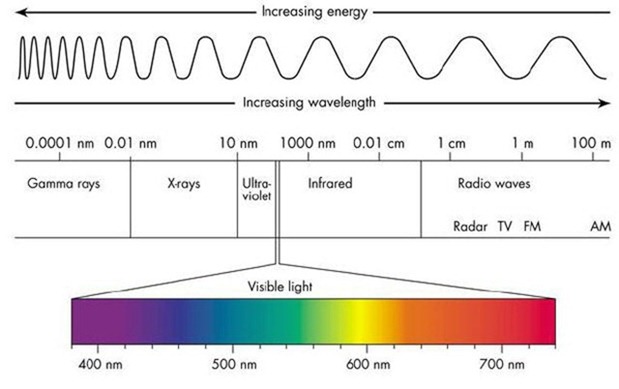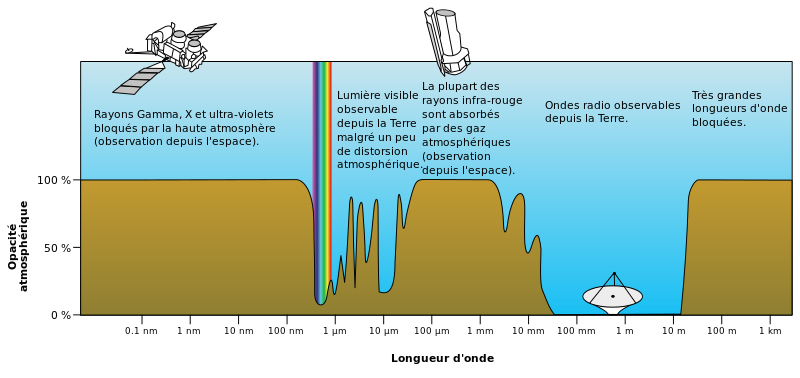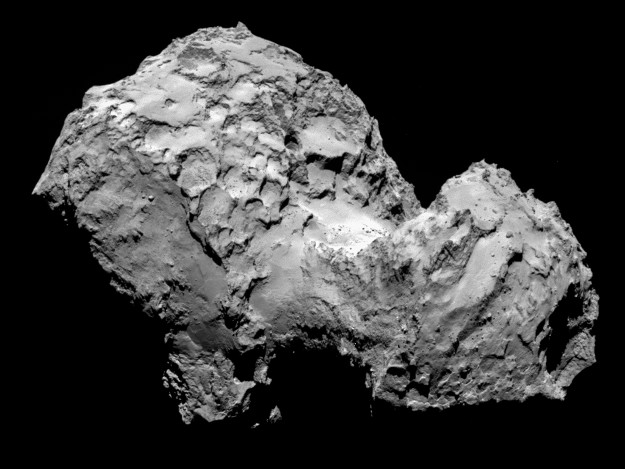This text evolved from several years of pondering about the place space science within society. Many of its elements were presented in talks given in June 2014 in Beijing and Shangai.
Until the early 1960s all the knowledge on celestial bodies and their physics was derived from observations in the visual domain of the electromagnetic spectrum (fig. 1). The only part of the electromagnetic spectrum, besides the radio domain, for which the atmosphere is transparent (fig. 2). The sky in this light is largely dominated by stars. With ground based telescopes we mainly observe the radiation emitted by the surface of objects which temperature lies in the few thousand degrees range. With this information in hand, we are able to deduce many of the properties of the interior of the stars, contrary to the expectations of the positivists of the 19th century. We also discovered in the course of the 20th century that stars are organised in large collections called galaxies, themselves often in groups or clusters. From these observations our predecessors deduced the major elements of the evolution of the cosmos, giving rise to the widely accepted big bang theory.

Fig. 1 The electromagnetic spectrum (source gurumed).

Fig. 2 The opacity of the Earth atmosphere. Where the opacity is 100% no radiation reaches the Earth surface (source wikipedia).
Impressive as they are, these findings left large parts of of the Universe undiscovered. The opening of new windows of the electro-magnetic spectrum to astronomical observations was made possible by the operation of radio telescopes on the ground and by spacecrafts on which observation instruments were placed in orbit around the Earth, outside the blocking atmosphere. Space borne instruments allowed us to discover that many types of objects emit most of their radiation outside the small window accessible from the ground with optical telescopes. Instruments sensitive in the radio domain and those sensitive in the ultraviolet, infrared and mm domains, in X-rays and gamma rays revealed not only unknown types of objects, but also a very rich set of physical processes and conditions that, for most, were unexpected. In situ observations using spacecrafts that traveled to planets in the solar system also discovered a largely unexpected breath of physical conditions.
One may mention, as examples, the presence of a very hot X-ray emitting gas in clusters of galaxies that outweighs the galaxies by an order of magnitude; the existence of black holes and neutron stars that accrete matter from companion stars and shine brightly in the X-rays; the presence of massive black holes in the centre of galaxies, some of which also accrete large fluxes of matter from their host galaxies that make them shine more than the sum of the 100 billion stars of their host galaxies; or the existence of bursts of gamma rays emitted unexpectedly from any direction in the sky for few seconds or less and that radiate a quantity of energy that can be close to the energy equivalent of the mass of the Sun. This physics is the realm of high energy astrophysics, it is described e.g. in “High Energy Astrophysics, an Introduction”, T.J.-L. Courvoisier, Springer Verlag 2012.
Space exploration of the solar system by robotic instruments also led to the discovery of unexpected conditions. The surface of the Galilean satellites of Jupiter, for example, differ immensely, they vary from the hot surface from which sulphur seeps out of the equivalent of volcanos on Io to the icy surface of Europa. Titan, the moon of of Saturn on which the spacecraft Huygens landed in 2005 was found to have lakes of methane. The shape, surface and composition of the comet 67P/Tschurjumow-Gerassimenko (fig. 3) explored by the Rosetta mission reveals a variety of features that surprises and the Hydrogen isotopic composition shows that the water on the comet and that on the Earth differ to such an extent that Earth water cannot originate from comets.

Fig. 3, the comet 67P/Churyumov-Gerasimenko . Credit: ESA/Rosetta/MPS for OSIRIS Team MPS/UPD/LAM/IAA/SSO/INTA/UPM/DASP/IDA
We have discovered during the decades since we gained access to space that the world that surrounds the Earth in its close neighbourhood and much further away is much more diversified than had been anticipated, entails regions in which physical conditions differ widely from those we meet daily or that we can generate in laboratories and varies in time much more wildly than observed from the surface of the Earth. In one word, space science has deeply changed our Weltbild.
Science was a prime mover of space activity. It was, however, never the only one. Reading J. Kennedy’s “Moon Speech” is interesting in this respect. In this speech given in Houston in 1962 one reads:
“ Those who came before us made certain that this country rode the first waves of the industrial revolutions, the first waves of modern invention, and the first wave of nuclear power, and this generation does not intend to founder in the backwash of the coming age of space. We mean to be a part of it--we mean to lead it. For the eyes of the world now look into space, to the moon and to the planets beyond, and we have vowed that we shall not see it governed by a hostile flag of conquest, but by a banner of freedom and peace. We have vowed that we shall not see space filled with weapons of mass destruction, but with instruments of knowledge and understanding. Yet the vows of this Nation can only be fulfilled if we in this Nation are first, and, therefore, we intend to be first . In short, our leadership in science and in industry, our hopes for peace and security, our obligations to ourselves as well as others, all require us to make this effort, to solve these mysteries, to solve them for the good of all men, and to become the world's leading spacefaring nation.”
Kennedy expresses that while knowledge and understanding are the goals of the space endeavour, the United-States will make every effort to become “the world's leading spacefaring nation” to use his words. Thus the geopolitical nature of the space effort is explicitly mentioned. This example is interesting for the clear, almost candid, presentation of the objectives that the the US would put every effort to achieve. It is certainly true that a similar mix of goals has been and is present in the space programmes of other major nations like the USSR and now Russia or China.
The show of power that early space efforts represented was little by little overtaken by the many practical devices that are made possible using satellites. Industry caught on and capitalised on the experience and technologies that were developed for scientific missions to build tools that are at present at the heart of civilisation and world development. We thus make now use of services that incorporate important space borne segments in weather forecast systems, monitoring of natural and man made ressources, military intelligence, telecommunication and geographical positioning ( and this list may well not be exhaustive). These services are not only used daily by all of us for our comfort or ease of life, they are central to the health of our societies and the military and police aspects of our security. Navigation in air, at sea or on roads relies nowadays in an essential way on the available satellite positioning systems, to mention but one example. Markets have developed around these services that far outrun the expenditure devoted to space sciences. Industry and the economy related to these services therefore tends now to estimate that the science that underpins all the developments is not worth pursuing in the new environment. This came to light in particular in a report analysing the European space science programme in 2007 (SPRT report to ESA 20070, where one may read:
“Nowadays space science helps us to understand the evolution of the Universe and the solar system including Earth. Space science in Europe has initially been the main driver for the development of space technologies, which were later the basis for many applications serving a wide range of societal needs. It provides tools and insights, which are of direct interest to mankind.” (in italics, my emphasis).
This does not mean that the geopolitical aspects of space faring have decreased in importance, quite on the contrary, it is now not only the image of a society that is displayed by space prowess, but its whole livelihood and economy that are at stake. Mastering space technologies has become a central issue for any society that wants to establish its population among the wealthy ones of this world. However, a consequence of this evolution is that the industrial support to space sciences has markedly decreased over the last decades.
A further consequence of our dependence on space technologies lies in the importance of the space sector in our economies. Mastering the tools needed to access outer space and operate spacecrafts has evolved from a somewhat esoteric activity of a few scientists to become a branch of engineering to which numerous highly skilled individuals devote their time, capacities and talent.
While this evolution is taking place, and despite budget constraints that have become very tight, the science performed from space and in space has continued to progress. Even now new types of objects are being discovered by satellites observing in spectral domains that have not yet been explored at high sensitivity. Our understanding of classes of objects improves as observations are gathered with ever improving instruments. Spacecrafts visit bodies of the solar system and keep surprising us by what is observed in situ. That this should be so is no surprise if we compare the few decades of space faring with the much longer time during which astronomical observations have been made on Earth. It is even less of a surprise if one takes into account the fact that only a small fraction of the electromagnetic spectrum is available for observations from the ground, most of the radiation that reaches us from outer space being blocked by the atmosphere. Since physical phenomena are taking place in the Universe without paying attention to the properties of our atmosphere, one should not wonder that accessing a much wider parameter space leads to the discovery of a richness in physics that defies the imagination.
Thus space technologies lie at the heart of modern civilisation, intellectually, practically and politically.
Mastering these space technologies is vital for us to continue enjoying the services associated with space, to exist on the world power game and to develop intellectually. This is also true in Europe where it seems difficult to enthuse all the states that are members of either the European Union (EU) or the European Space Agency (ESA) or both to provide the necessary funding. With budgets that are consistently less than those of the US, and soon of China, I imagine, Europe keeps itself in a dependence status vis a vis the US; thus weakening considerably its position on the intellectual, economical and political world maps.
Measured in terms of the benefits gained from investments in space based tools and technologies, the space industry expenses are modest. Sophisticated satellites, typically for ambitious scientific missions, cost of the order of 500 Millions to 1 billion Euros (or equivalent currencies). These costs are spent (always on Earth) over a period of 10 years. In Europe they are supported by a population of the order of 500 million inhabitants. The cost per year and per person is thus of the order of 0.1 Euro per satellite or space project. The knowledge or services or prestige that is acquired with this investment from a given project or mission and that are available to all, be it as scientific knowledge or improved weather forecasts or other services are well worth this expense. Not making this financial effort would mean to take severe steps back in terms of independence for the provision of services or of international credibility or of intellectual capacity.
The world is at present divided in a number of continental size entities, of which Europe is one. The arguments made here for Europe are valid for all of them in a similar way. These entities do have populations that, like Europe, are of the order of or larger than the 500 million inhabitants of Europe, the funding arguments are, therefore, similar for all these entities. The political scene is at present such that it is difficult to envisage that all the benefits of space programmes be shared worldwide. As long as this will be so, we will develop a certain level of redundancy as all players feel the need to develop similar projects and programs. One can only hope that in the longer term the unnecessary duplication of effort may be avoided, possibly through the creation of a world space agency. But for now this is political fiction rather than a credible development path.
Science is thus at the origin of a major step in the development of our civilisation. The whole space sector could only be developed thanks to the curiosity, efforts and vision of the space science community. It is probably true to state that no one had anticipated the breadth of the services made possible by the inclusion of space and space technologies among the tools available to our societies. Arguing now that science is not any more worth the solid financial commitment needed in the space sector is quite possibly precluding future developments of a similar nature.



